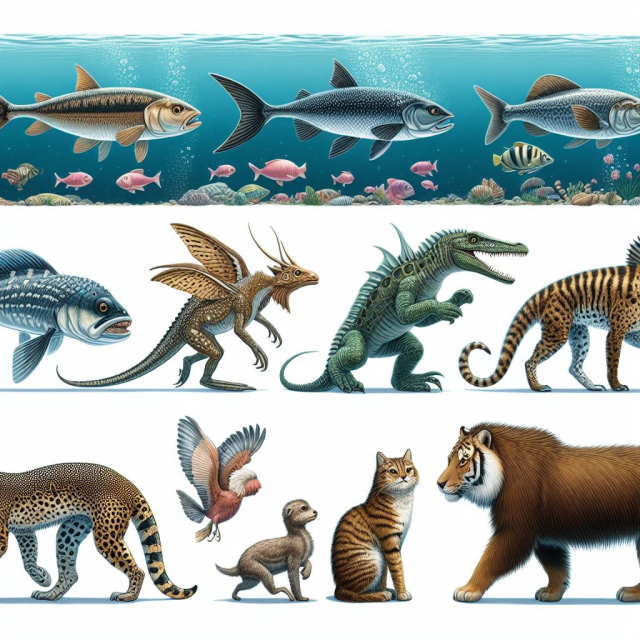Animal evolution is a fascinating topic that spans millions of years of biological changes and adaptations. From the simplest forms of life to the complexities of modern mammals, evolution has shaped the animal diversity we see today. This article will explore the major milestones in animal evolution, highlighting the key processes and events that have led to the richness of animal life on Earth.
Origins of Animal Life.
The Precambrian and the First Metazoans.
Animal life began in the Precambrian, more than 600 million years ago, with the appearance of the first metazoans, multicellular organisms. Fossils of the Ediacaran biota, discovered in Australia and elsewhere, represent some of the oldest forms of life. These simple organisms, such as jellyfish and flatworms, laid the foundation for future animal diversity.
The Cambrian Explosion.
Approximately 541 million years ago, the Cambrian explosion marked a turning point in animal evolution. During this brief geological period, the diversity of life forms increased dramatically. The first representatives of many modern animal phyla appeared, including arthropods, mollusks, and vertebrates. The appearance of skeletal structures and the differentiation of complex tissues allowed a greater variety of forms and ways of life.
The Colonization of the Earth.
Aquatic Vertebrates.
Vertebrates began their evolution in water. The first jawless fish, such as ostracoderms, evolved about 500 million years ago. The appearance of jaws in placoderm and acanthodian fishes was a significant development, allowing for greater diversity in diet and behavior.
The Transition to Earth.
The transition of vertebrates from water to land was one of the most important events in animal evolution. About 375 million years ago, early tetrapods, such as Tiktaalik, began to develop limbs adapted for terrestrial life. These early amphibians still depended on water for reproduction, but they laid the foundation for the evolution of reptiles and mammals.
The age of the dinosaurs.
The Diversification of Reptiles.
During the Mesozoic, between 252 and 66 million years ago, reptiles dominated the Earth. Dinosaurs, a diverse group of reptiles, evolved in a wide variety of shapes and sizes. Giant sauropods, such as Brachiosaurus, and fearsome carnivores, such as Tyrannosaurus rex, are emblematic examples of dinosaur diversity.
The Appearance of Birds.
Birds evolved from small theropod dinosaurs during the Late Jurassic. Archeopteryx, one of the earliest known bird fossils, displays a combination of dinosaur and bird features, such as feathers and bone structures specialized for flight. The evolution of birds represents a classic example of how large groups of animals can diversify and adapt to new ecological niches.
The Evolution of Mammals.
The First Mammals.
Mammals evolved from reptilian synapsids during the Late Triassic. Early mammals, like Morganucodon, were small and nocturnal, adapted to a world dominated by dinosaurs. They developed key characteristics such as lactation and hair, which allowed them to survive in various environments.
The Diversification of Mammals.
After the extinction of the dinosaurs 66 million years ago, mammals diversified rapidly. Various groups of mammals emerged, including monotremes (mammals that lay eggs), marsupials (mammals with developing young in a pouch), and placentals (mammals that develop their young internally). This diversification allowed mammals to occupy a variety of ecological niches, from the oceans to the skies and all terrestrial habitats.
Adaptations and Diversification.
Structural and Functional Adaptations.
Animal evolution has been driven by numerous structural and functional adaptations. For example, vertebrate limbs have evolved for various modes of locomotion, such as walking, flying, and swimming. Physiological adaptations, such as the development of efficient respiratory and circulatory systems, have allowed animals to exploit a wide range of habitats.
Coevolution and Symbiosis.
Coevolution, the joint evolution of two or more closely interacting species, has been a key factor in animal evolution. Predator-prey relationships, pollinator-plant interactions, and mutualistic symbioses have given rise to an impressive diversity of life forms and behaviors. For example, the relationship between flowers and their pollinators has led to an extraordinary diversity of shapes and colors in flowering plants and specific adaptations in pollinating insects.
Contemporary Evolution and the Future.
Evolution in the Modern Era.
Evolution is not a process of the past; continues today. Natural selection, genetic drift and mutation continue to shape animal populations. Contemporary evolutionary studies have shown how rapid changes in the environment can lead to real-time adaptations. For example, bacteria and other microorganisms have rapidly evolved to resist antibiotics, posing significant challenges for medicine.
The Human Impact.
Humans have had a profound impact on the evolution of other species. Hunting, habitat destruction, the introduction of invasive species, and climate change have altered evolutionary patterns around the world. Some species have managed to adapt to urban environments created by humans, while others have been pushed to the brink of extinction.
Conservation and the Future of Animal Evolution.
Biodiversity conservation is crucial for the future of animal evolution. Efforts to protect natural habitats, restore degraded ecosystems, and conserve threatened species are vital to ensuring that evolution continues sustainably. Furthermore, scientific research and public education are essential to increase awareness of the importance of biodiversity and evolutionary processes.
The evolution of animals is a story of dynamic changes and incredible adaptations that have given rise to the astonishing diversity of life forms we see today. From the first multicellular organisms in the Precambrian to the vast range of modern species, evolution has been driven by natural selection, mutation and interaction between species. Understanding this history allows us to appreciate the richness of life on Earth and highlights the importance of conserving biodiversity for future generations. As we continue to explore and discover new aspects of evolution, each finding provides us with deeper insight into the processes that have shaped and will continue to shape the natural world.
